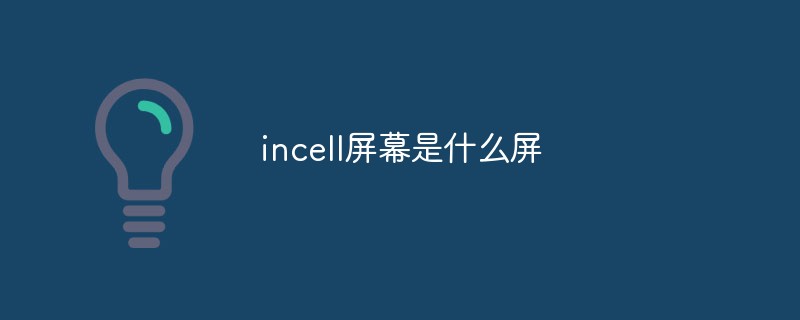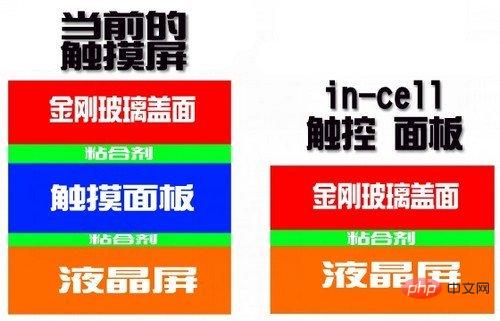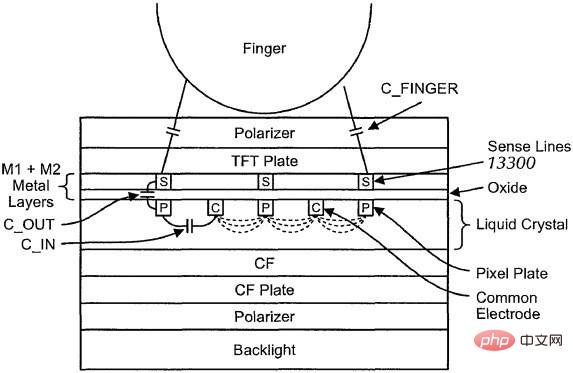
incell screen is a touch screen. Incell is a screen bonding technology, which represents the integrated bonding process of touch panels and LCD panels; that is, embedding the touch panel into the liquid crystal pixels. The benefit of Incell technology is to reduce the thickness of mobile phones, allowing mobile phone manufacturers to make more effective use of the internal space of mobile phones; in addition, screens using Incell technology have better display quality.

#The operating environment of this tutorial: IOS 16 system, iphone13 mobile phone.
The in-cell screen is a touch screen type.
Incell screen introduction
Incell screen is a screen lamination technology, which represents the integration of touch panel and LCD The panel is integrated and bonded. That is to embed the touch panel into the liquid crystal pixels. Incell technology first appeared on Apple's iPhone 5. The benefit it brings is to reduce the thickness of the phone, allowing mobile phone manufacturers to make more effective use of the internal space of the phone. In addition, screens using incell technology have better display quality. Incell technology has now developed very maturely, and the yield rates of major manufacturers are also constantly improving.
In-cell screens have two related technologies: in-cell and on-cell
In-cell refers to embedding touch panel functions into liquid crystal pixels method.
On-cell refers to a method of embedding the touch panel function between the color filter substrate and the polarizing plate.

In-Cell technology
In-Cell refers to embedding touch panel functions into liquid crystal pixels The method is to embed the touch sensor function inside the display screen, which can make the screen thinner and lighter. At the same time, the In-Cell screen must be embedded with a matching touch IC, otherwise it will easily lead to erroneous touch sensing signals or excessive noise. Therefore, for any display panel manufacturer, the threshold for entering In-Cell/On-Cell touch screen technology is indeed quite high, and it still needs to overcome the difficulty of low yield rate. Currently, in-Cell technology is used in addition to Apple's iPhone 5 and Nokia's Lumia 920, as well as Huawei's Ascend P6 and Google Nexus5. The thickness of the iPhone 5 screen is estimated to be 2.54mm, and the In-Cell thinning contribution is 0.44mm, accounting for approximately 25% of the 1.7mm thickness decrease.

Extended knowledge: The difference between incell screen and ips
The full name of Ips screen is In-PlaneSwitching , it was launched in 2001 and was called "SuperTFT" at that time, that is to say, ips is based on TFT screen. Unlike other LCD panels, its two poles are on the upper and lower planes, and its electrodes are on the same plane. People's first awareness of IPS screens was on the iPhone 4 launched by Apple. At that time, people were amazed by the screen display effect of iPhone4. True colors, excellent pictures, and accurate colors are the major advantages of IPS screens. In addition, the IPS screen also has the characteristics of fast response speed, large viewing angle, environmental protection and power saving, and no water marks on touch. Nowadays, more and more mobile phones are beginning to use IPS screens.
The difference between the two:
The biggest difference between Incell screen and ips screen is that incell is a type of screen lamination technology, and ips screen is a real screen. For example, Apple's iPhone 5 uses incell technology, but its screen is still an IPS screen. The combination of the two allows users to enjoy better screen quality effects.
For more related knowledge, please visit the FAQ column!
The above is the detailed content of What is an incell screen?. For more information, please follow other related articles on the PHP Chinese website!